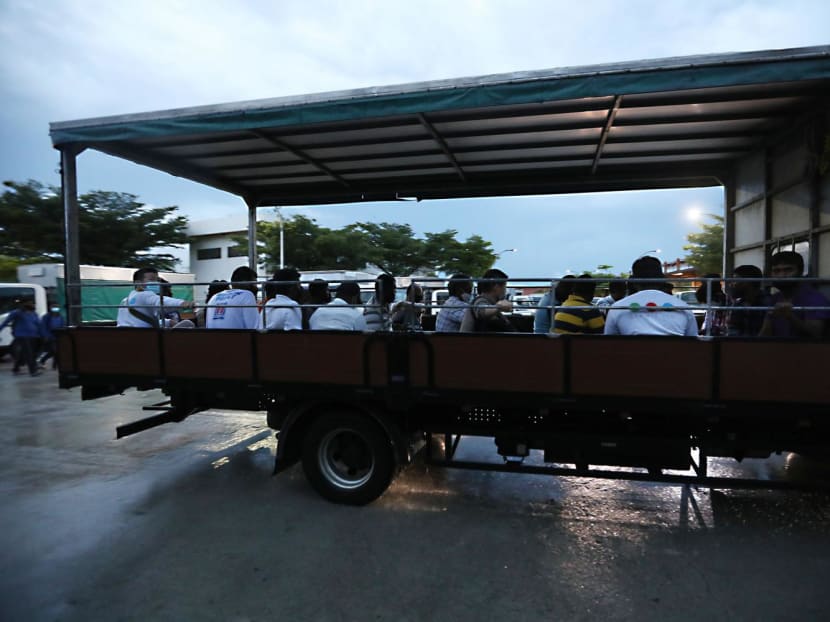Migrant workers' groups welcome new rules but call for more to be done to ensure safety on lorries
SINGAPORE — Migrant worker rights groups here have welcomed new measures announced by the Government aimed at ferrying workers more safely on lorries, but they also raised concerns about companies potentially getting around the rules and called for bolder actions to boost safety.

A file photograph of workers being ferried on the back of a lorry.
- Migrant worker groups welcome recently announced regulations to enhance safety standards when ferrying workers on the back of lorries
- However, they said that these measures did not address the "inherent" safety risk of transporting them using lorries
- The measures also put additional responsibilities on the shoulders of workers, who are already in a precarious employment position, some groups say
SINGAPORE — Migrant worker rights groups here have welcomed new measures announced by the Government aimed at ferrying workers more safely on lorries, but they also raised concerns about companies potentially getting around the rules and called for bolder actions to boost safety.
These groups suggested, among other things, giving incentives to companies which willingly take bolder steps to ensure the safety of workers, and using technology instead of expecting workers to shoulder more safety-related responsibilities when they are already in a "precarious" employment position.
Meanwhile, one construction company shared with TODAY the challenges it has faced when transporting workers using buses, and some safety measures it currently implements.
The authorities on Wednesday (Oct 19) announced a mandatory rest period of at least 30 minutes for onsite workers who also double as drivers — if they worked for at least six hours — before they can transport other workers in the rear deck of lorries.
A worker must also be assigned as a “buddy” to ensure the driver is fit to drive and stays alert while driving, as part of a new slew of measures that kicks in next January.
Also to be rolled out in phases starting next year, is the mandatory installation of rain covers on the back of lorries to shield workers from bad weather.
The details were unveiled after the Government had broadly outlined the measures in March, following debates on workers’ transportation safety that were sparked by a spate of road accidents involving lorries ferrying workers.
When asked by TODAY on the latest accident figures involving lorries ferrying workers, the Singapore Police Force referred to a parliamentary reply by Home Affairs and Law Minister K Shanmugam earlier this month.
Mr Shanmugam had said: “The Traffic Police is only able to provide data on accidents involving passengers of lorries which resulted in casualties or deaths.
“It does not track the occupation of the passengers, if they are workers or otherwise, or if they are specifically seated in the front or the rear of the lorry.”
The minister shared that 95 of such accidents had occurred in 2021, with one accident causing at least one fatality.
A WELCOME MOVE, BUT INSUFFICIENT
Ms Dipa Swaminathan, founder of migrant worker advocacy and charity group ItsRainingRaincoats, said that “any step” to improve safety for workers is a welcome measure.
Similarly, the National Trades Union Congress (NTUC) said that it was glad that the authorities are taking steps to enhance regulations to ensure driver alertness and thereafter reduce the chances of incidents occurring.
“Fatigue can lead to a lack of concentration, which is one of the causes of incidents involving vehicles,” said NTUC assistant secretary-general Melvin Yong.
However, both Mr Yong and Ms Dipa were quick to point out that the measures announced may not be sufficient.
“A 30-minute rest period may not be sufficient as workers are likely to be involved in heavy manual work during most of their work day,” said Mr Yong.
A spokesperson for Humanitarian Organisation for Migration Economics (Home), said the mandatory rest period “must be strictly enforced”.
Ms Dipa felt that an oversight mechanism, such as spot checks, needs to be carried out to ensure companies abide by the spirit of the regulation and not merely the letter of it.
For example, companies might ask these workers who double as drivers to work for slightly less than six hours so that they do not need to be given the mandated rest period.
Care should be taken to ensure employers do not dock the rest period from the worker’s lunch break, or ask them to make up for the rest period another time, she said.
SHOULD NOT ADD TO WORKERS’ 'PRECARITY'
The spokesperson from Home said that the additional responsibility of ensuring safety should not fall on the workers’ shoulders alone.
Ms Dipa, too, felt workers cannot be expected to be the only ones ensuring that safety measures are strictly enforced, as they might not be in a position to whistleblow on errant employers.
“They would fear losing their jobs if they complained to anybody. So somebody will need to monitor whether these (measures) are actually being implemented or not,” she said.
More importantly, safety cannot be determined by the driver alone, she said
“And it's not fair to place all the burden on the (worker), this makes it seem like it's all down to the driver — (as if that) as long as the driver is safe, we can just continue indefinitely without seatbelts and lorries. This should not be the case,” she said.
Home said that safety measures “should not add to the precarity” that many workers already face.
“Measures such as the ‘vehicle buddy’ impose the responsibility of checking that the driver is ‘fit to drive and remains alert’ on other workers — these workers may be penalised if they are deemed to have fallen short,” said the Home spokesperson.
GOING BEYOND WORKERS
The groups also put forward some suggestions beyond the announced measures to further enhance safety.
“We should move towards requiring companies who transport workers on their vehicles to have dedicated drivers, as opposed to workers doubling up as drivers, to reduce the possibility of an incident,” said Mr Yong.
He added that companies should be encouraged to adopt technology available in the market to assess the driver’s level of fatigue, to reduce the likelihood of human error on the part of the designated "buddy" monitoring the driver’s tiredness and alertness.
Ms Dipa said rewards should be given to companies which voluntarily move to using safer modes of transport like buses, to incentivise other companies to do so.
WHAT COMPANIES SAID
TODAY reached out to a few companies to ask about the new regulations announced and the challenges they face in general when implementing safety measures.
Senior manager at integrated construction company Samwoh Corporation, Mr Seah Kok Hua, replied briefly: “We don’t foresee any challenges in implementing these safety measures”.
Similarly, Mr Allan Low, deputy director for quality, environment health and safety at Teambuild Construction Group, welcomed the measures and said that his firm does not foresee much issue in implementing them.
He shared that Teambuild had tried ferrying workers with buses before.
“The availability and timing of vehicles were all controlled by the vehicle company. So if and when the company failed to give us a bus, we faced lots of logistical issues,” he said.
He added these issues are impeding the wider usage of buses for worker transport and if they can be addressed, his company would “definitely” consider reverting to using buses to transport workers.
Senior Minister of State for Transport Amy Khor had in Parliament noted that similar operational concerns were raised by companies during the authorities' consultations with the industry, and reiterated this during the launch of the recent safety measures.
For its part, Teambuild has taken steps to ensure the safety of its workers on the road, such as putting trackers on all its 25 lorries and constantly monitoring their drivers — all of whom are dedicated transport operators who do not double as onsite workers — to ensure that they do not speed or drive recklessly.
Meanwhile, migrant worker groups urge that bolder steps be taken to safeguard the lives of workers being transported on lorries.
“These measures do not address the fact that lorries are structurally unsafe to transport people,” said the Home spokesperson.
“Without outlawing the practice of ferrying workers on lorries, inherent safety risks remain.”
Ms Dipa noted that the higher cost of using buses to transport workers has often been cited as a reason why lorries are used instead, but she said that strong transportation safety measures had been implemented before despite being costly, such as making seatbelts compulsory in school buses.
“We don't say: ‘Oh, it's expensive, to take all school children in buses fitted with seatbelts’. It's just non-negotiable, right? ... so how come it's negotiable, just for workers?Ms Dipa Swaminathan, founder of migrant worker advocacy and charity group ItsRainingRaincoats”
“We don't say: ‘Oh, it's expensive, to take all school children in buses fitted with seatbelts’. It's just non-negotiable, right?,” she added.
“But if for the rest of us it is non-negotiable, so how come it's negotiable, just for workers?”











